點(diǎn)云數(shù)據(jù)——The Point Cloud Data
點(diǎn)云數(shù)據(jù)應(yīng)表示為具有N行和至少3列的numpy數(shù)組。每行對(duì)應(yīng)于單個(gè)點(diǎn),其在空間(x,y,z)中的位置使用至少3個(gè)值表示。
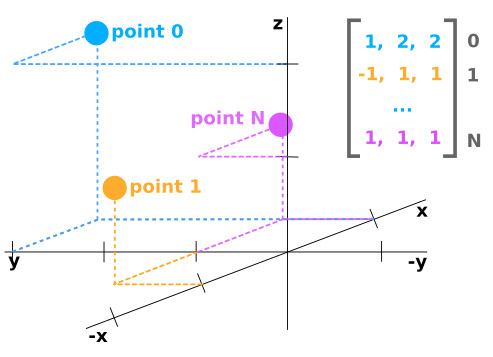
如果點(diǎn)云數(shù)據(jù)來(lái)自LIDAR傳感器,那么它可能具有每個(gè)點(diǎn)的附加值,例如“反射率”,其是在該位置中障礙物反射多少激光光束的量度。在這種情況下,點(diǎn)云數(shù)據(jù)可能是Nx4陣列。
圖像與點(diǎn)云坐標(biāo)——Image vs Point Cloud Coordinates
點(diǎn)云的軸與圖像中的軸具有完全不同的含義。下圖顯示了藍(lán)色的圖像軸和橙色的點(diǎn)云軸。
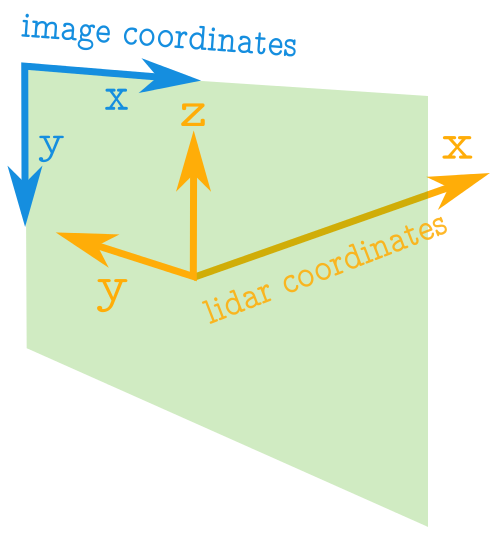
關(guān)于圖像需要注意的一些重要事項(xiàng):
-
圖像中的坐標(biāo)值始終為正。
-
原點(diǎn)位于左上角。
-
坐標(biāo)是整數(shù)值。
有關(guān)點(diǎn)云坐標(biāo)的注意事項(xiàng):
-
點(diǎn)云中的坐標(biāo)值可以是正數(shù)或負(fù)數(shù)。
-
坐標(biāo)可以采用實(shí)數(shù)值。
-
正x軸表示向前。
-
正y軸表示左。
-
正z軸表示向上。
創(chuàng)建點(diǎn)云數(shù)據(jù)的Birdseye視圖
鳥瞰圖的相關(guān)軸 為了創(chuàng)建鳥眼視圖圖像,來(lái)自點(diǎn)云數(shù)據(jù)的相關(guān)軸將是x和y軸。
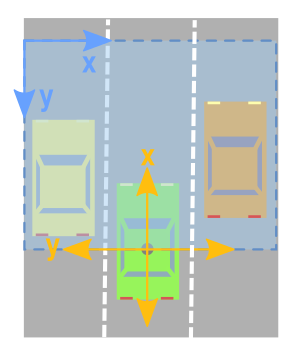
但是,正如我們從上圖所示,我們必須小心并考慮以下事項(xiàng): x和y軸意味著相反的事情。 x和y軸指向相反的方向。 您必須移動(dòng)值,以便(0,0)是圖像中可能的最小值。
1.限制矩形看——Limiting Rectangle to Look at
僅關(guān)注點(diǎn)云的特定區(qū)域通常很有用。因此,我們希望創(chuàng)建一個(gè)僅保留我們感興趣的區(qū)域內(nèi)的點(diǎn)的過(guò)濾器。 由于我們正在查看頂部的數(shù)據(jù),并且我們有興趣將其轉(zhuǎn)換為圖像,因此我將使用與圖像軸更加一致的方向。下面,我指定我想要集中在相對(duì)于原點(diǎn)的值的范圍。原點(diǎn)左側(cè)的任何內(nèi)容都將被視為負(fù)數(shù),而右側(cè)的任何內(nèi)容都將被視為正數(shù)。點(diǎn)云的x軸將被解釋為向前方向(這將是我們的鳥眼圖像的向上方向)。 下面的代碼將感興趣的矩形設(shè)置為在原點(diǎn)的兩側(cè)跨越10米,并在其前面20米處。
side_range=(-10, 10) # left-most to right-most
fwd_range=(0, 20) # back-most to forward-most
2.接下來(lái),我們創(chuàng)建一個(gè)過(guò)濾器,僅保留實(shí)際位于我們指定的矩形內(nèi)的點(diǎn)。
# EXTRACT THE POINTS FOR EACH AXIS
x_points = points[:, 0]
y_points = points[:, 1]
z_points = points[:, 2]
# FILTER - To return only indices of points within desired cube
# Three filters for: Front-to-back, side-to-side, and height ranges
# Note left side is positive y axis in LIDAR coordinates
f_filt = np.logical_and((x_points > fwd_range[0]), (x_points < fwd_range[1]))
s_filt = np.logical_and((y_points > -side_range[1]), (y_points < -side_range[0]))
filter = np.logical_and(f_filt, s_filt)
indices = np.argwhere(filter).flatten()
# KEEPERS
x_points = x_points[indices]
y_points = y_points[indices]
z_points = z_points[indices]
3.將點(diǎn)位置映射到像素位置——Mapping Point Positions to Pixel Positions
目前,我們有一堆帶有實(shí)數(shù)值的點(diǎn)。為了映射這些值,將這些值映射到整數(shù)位置值。我們可以天真地將所有x和y值整合到整數(shù)中,但我們最終可能會(huì)失去很多分辨率。例如,如果這些點(diǎn)的測(cè)量單位是以米為單位,則每個(gè)像素將表示點(diǎn)云中1x1米的矩形,我們將丟失任何小于此的細(xì)節(jié)。如果你有一個(gè)類似山景的點(diǎn)云,這可能沒(méi)問(wèn)題。但是如果你想能夠捕捉更精細(xì)的細(xì)節(jié)并識(shí)別人類,汽車,甚至更小的東西,那么這種方法就沒(méi)有用了。
但是,可以稍微修改上述方法,以便我們獲得所需的分辨率級(jí)別。在對(duì)整數(shù)進(jìn)行類型轉(zhuǎn)換之前,我們可以先擴(kuò)展數(shù)據(jù)。例如,如果測(cè)量單位是米,我們想要5厘米的分辨率,我們可以做如下的事情:
res = 0.05
# CONVERT TO PIXEL POSITION VALUES - Based on resolution
x_img = (-y_points / res).astype(np.int32) # x axis is -y in LIDAR
y_img = (-x_points / res).astype(np.int32) # y axis is -x in LIDAR
您會(huì)注意到x軸和y軸交換,方向反轉(zhuǎn),以便我們現(xiàn)在可以開始處理圖像坐標(biāo)。
更改坐標(biāo)原點(diǎn)——Shifting to New Origin
x和y數(shù)據(jù)仍未準(zhǔn)備好映射到圖像。我們可能仍然有負(fù)x和y值。所以我們需要將數(shù)據(jù)移位到(0,0)最小值。
# SHIFT PIXELS TO HAVE MINIMUM BE (0,0)
# floor and ceil used to prevent anything being rounded to below 0 after shift
x_img -= int(np.floor(side_range[0] / res))
y_img += int(np.ceil(fwd_range[1] / res))
現(xiàn)在數(shù)據(jù)值都為正值
>>> x_img.min()
7
>>> x_img.max()
199
>>> y_img.min()
1
>>> y_img.max()
199
像素值——Pixel Values
我們已經(jīng)使用點(diǎn)數(shù)據(jù)來(lái)指定圖像中的x和y位置。我們現(xiàn)在需要做的是指定我們想要用這些像素位置填充的值。一種可能性是用高度數(shù)據(jù)填充它。要做的兩件事
請(qǐng)記住:
像素值應(yīng)為整數(shù)。
像素值應(yīng)該是0-255范圍內(nèi)的值。
我們可以從數(shù)據(jù)中獲取最小和最大高度值,并重新縮放該范圍以適應(yīng)0-255的范圍。另一種方法,這里將使用的方法是設(shè)置我們想要集中的高度值范圍,并且高于或低于該范圍的任何內(nèi)容都被剪切為最小值和最大值。這很有用,因?yàn)樗试S我們從感興趣的區(qū)域獲得最大量的細(xì)節(jié)。
height_range = (-2, 0.5) # bottom-most to upper-most
# CLIP HEIGHT VALUES - to between min and max heights
pixel_values = np.clip(a = z_points,
a_min=height_range[0],
a_max=height_range[1])
在下面的代碼中,我們將范圍設(shè)置為原點(diǎn)下方2米,高于原點(diǎn)半米。接下來(lái),我們將這些值重新縮放到0到255之間,并將類型轉(zhuǎn)換為整數(shù)。
def scale_to_255(a, min, max, dtype=np.uint8):
""" Scales an array of values from specified min, max range to 0-255
Optionally specify the data type of the output (default is uint8)
"""
return (((a - min) / float(max - min)) * 255).astype(dtype)
# RESCALE THE HEIGHT VALUES - to be between the range 0-255
pixel_values = scale_to_255(pixel_values, min=height_range[0], max=height_range[1])
創(chuàng)建圖像陣列——Create the Image Array
現(xiàn)在我們準(zhǔn)備實(shí)際創(chuàng)建圖像,我們只是初始化一個(gè)數(shù)組,其尺寸取決于我們?cè)诰匦沃兴璧闹捣秶臀覀冞x擇的分辨率。然后我們使用我們轉(zhuǎn)換為像素位置的x和y點(diǎn)值來(lái)指定數(shù)組中的索引,并為這些索引分配我們選擇的值作為前一小節(jié)中的像素值。
# INITIALIZE EMPTY ARRAY - of the dimensions we want
x_max = 1+int((side_range[1] - side_range[0])/res)
y_max = 1+int((fwd_range[1] - fwd_range[0])/res)
im = np.zeros([y_max, x_max], dtype=np.uint8)
# FILL PIXEL VALUES IN IMAGE ARRAY
im[y_img, x_img] = pixel_values
預(yù)覽——Viewing
目前,圖像存儲(chǔ)為numpy數(shù)組。如果我們希望將其可視化,我們可以將其轉(zhuǎn)換為PIL圖像,并查看它。
# CONVERT FROM NUMPY ARRAY TO A PIL IMAGE
from PIL import Image
im2 = Image.fromarray(im)
im2.show()
我們作為人類并不善于分辨灰色陰影之間的差異,因此它可以幫助我們使用光譜顏色映射來(lái)讓我們更容易分辨出價(jià)值差異。我們可以在matplotlib中做到這一點(diǎn)。(實(shí)際無(wú)法正常顯示)
import matplotlib.pyplot as plt
plt.imshow(im, cmap="spectral", vmin=0, vmax=255)
plt.show()
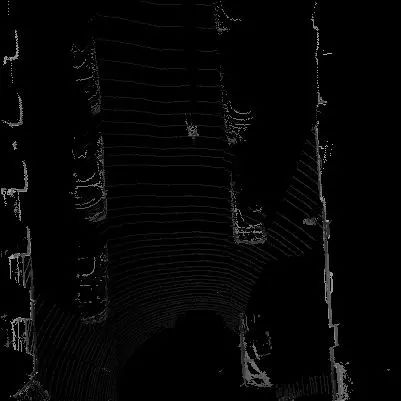
它實(shí)際上編碼與PIL繪制的圖像完全相同的信息量,因此機(jī)器學(xué)習(xí)學(xué)習(xí)算法例如仍然能夠區(qū)分高度差異,即使我們?nèi)祟惒荒芊浅G宄乜吹讲町悺?/span>
import cv2
#通過(guò)cv2顯示
cv2.imshow("im",im)
cv2.waitKey()
cv2.destroyAllWindows()
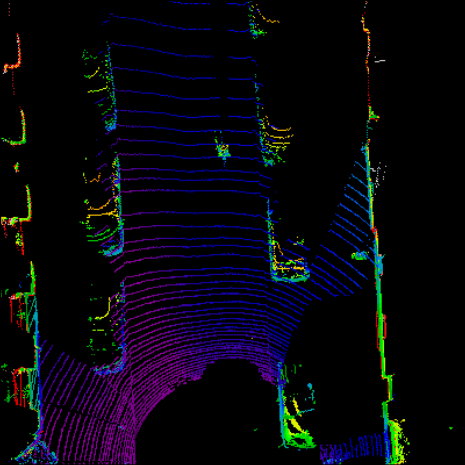
完整代碼——Complete Code
為方便起見,我將上面的所有代碼放在一個(gè)函數(shù)中,它將鳥瞰視圖作為一個(gè)numpy數(shù)組返回。然后,您可以選擇使用您喜歡的任何方法對(duì)其進(jìn)行可視化,或者將numpy數(shù)組插入到機(jī)器學(xué)習(xí)算法中。
import numpy as np
# ==============================================================================
# SCALE_TO_255
# ==============================================================================
def scale_to_255(a, min, max, dtype=np.uint8):
""" Scales an array of values from specified min, max range to 0-255
Optionally specify the data type of the output (default is uint8)
"""
return (((a - min) / float(max - min)) * 255).astype(dtype)
# ==============================================================================
# POINT_CLOUD_2_BIRDSEYE
# ==============================================================================
def point_cloud_2_birdseye(points,
res=0.1,
side_range=(-10., 10.), # left-most to right-most
fwd_range = (-10., 10.), # back-most to forward-most
height_range=(-2., 2.), # bottom-most to upper-most
):
""" Creates an 2D birds eye view representation of the point cloud data.
Args:
points: (numpy array)
N rows of points data
Each point should be specified by at least 3 elements x,y,z
res: (float)
Desired resolution in metres to use. Each output pixel will
represent an square region res x res in size.
side_range: (tuple of two floats)
(-left, right) in metres
left and right limits of rectangle to look at.
fwd_range: (tuple of two floats)
(-behind, front) in metres
back and front limits of rectangle to look at.
height_range: (tuple of two floats)
(min, max) heights (in metres) relative to the origin.
All height values will be clipped to this min and max value,
such that anything below min will be truncated to min, and
the same for values above max.
Returns:
2D numpy array representing an image of the birds eye view.
"""
# EXTRACT THE POINTS FOR EACH AXIS
x_points = points[:, 0]
y_points = points[:, 1]
z_points = points[:, 2]
# FILTER - To return only indices of points within desired cube
# Three filters for: Front-to-back, side-to-side, and height ranges
# Note left side is positive y axis in LIDAR coordinates
f_filt = np.logical_and((x_points > fwd_range[0]), (x_points < fwd_range[1]))
s_filt = np.logical_and((y_points > -side_range[1]), (y_points < -side_range[0]))
filter = np.logical_and(f_filt, s_filt)
indices = np.argwhere(filter).flatten()
# KEEPERS
x_points = x_points[indices]
y_points = y_points[indices]
z_points = z_points[indices]
# CONVERT TO PIXEL POSITION VALUES - Based on resolution
x_img = (-y_points / res).astype(np.int32) # x axis is -y in LIDAR
y_img = (-x_points / res).astype(np.int32) # y axis is -x in LIDAR
# SHIFT PIXELS TO HAVE MINIMUM BE (0,0)
# floor & ceil used to prevent anything being rounded to below 0 after shift
x_img -= int(np.floor(side_range[0] / res))
y_img += int(np.ceil(fwd_range[1] / res))
# CLIP HEIGHT VALUES - to between min and max heights
pixel_values = np.clip(a=z_points,
a_min=height_range[0],
a_max=height_range[1])
# RESCALE THE HEIGHT VALUES - to be between the range 0-255
pixel_values = scale_to_255(pixel_values,
min=height_range[0],
max=height_range[1])
# INITIALIZE EMPTY ARRAY - of the dimensions we want
x_max = 1 + int((side_range[1] - side_range[0]) / res)
y_max = 1 + int((fwd_range[1] - fwd_range[0]) / res)
im = np.zeros([y_max, x_max], dtype=np.uint8)
# FILL PIXEL VALUES IN IMAGE ARRAY
im[y_img, x_img] = pixel_values
return im
審核編輯 :李倩
-
傳感器
+關(guān)注
關(guān)注
2548文章
50698瀏覽量
752051 -
點(diǎn)云數(shù)據(jù)
+關(guān)注
關(guān)注
0文章
13瀏覽量
1504
原文標(biāo)題:點(diǎn)云數(shù)據(jù)詳解——點(diǎn)云數(shù)據(jù)變?yōu)閳D像
文章出處:【微信號(hào):vision263com,微信公眾號(hào):新機(jī)器視覺(jué)】歡迎添加關(guān)注!文章轉(zhuǎn)載請(qǐng)注明出處。
發(fā)布評(píng)論請(qǐng)先 登錄
相關(guān)推薦
dlp4500 點(diǎn)云數(shù)據(jù)
從D435獲得完整的點(diǎn)云但數(shù)據(jù)集不完整
點(diǎn)云格式主要有哪幾種
一種多幅點(diǎn)云數(shù)據(jù)與紋理序列自動(dòng)配準(zhǔn)方法

創(chuàng)建點(diǎn)云數(shù)據(jù)的Birdseye視圖
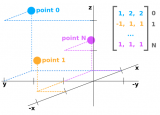
點(diǎn)云數(shù)據(jù)——The Point Cloud Data
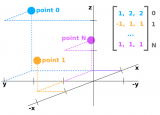
點(diǎn)云的概念以及與三維圖像的關(guān)系





 點(diǎn)云數(shù)據(jù)詳解——點(diǎn)云數(shù)據(jù)變?yōu)閳D像
點(diǎn)云數(shù)據(jù)詳解——點(diǎn)云數(shù)據(jù)變?yōu)閳D像











評(píng)論